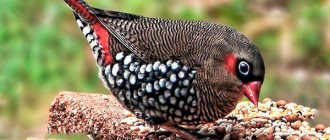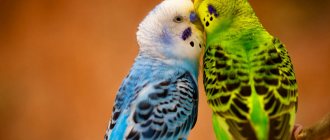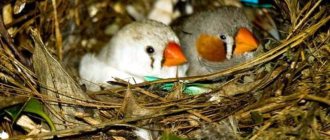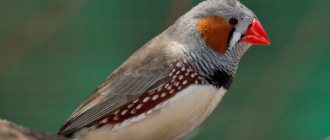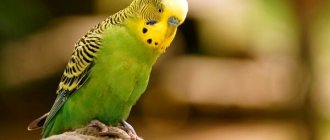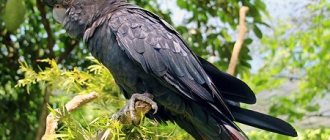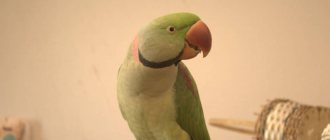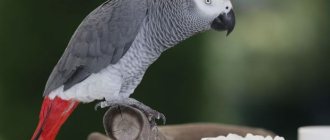Finches are small birds from the family of Finches, which are often kept at home. These birds are very sociable and cannot stand being alone, so they are usually kept in pairs or groups. In such conditions, many owners begin to strive to obtain offspring from their pets. Amadins are easy to breed in captivity, but the emerging finch chicks require special care and proper care from the poultry farmer, which will allow them to be raised into healthy birds.
After how many days and how do finches chicks hatch?
The female lays up to 5 eggs per clutch and begins the incubation process with the last egg so that all the chicks hatch at the same time. The male also participates in brooding, replacing the mother. This is the time she eats and rests.
The chicks hatch on days 12–18, depending on the variety. First, they use their beaks to break through the eggshell from the inside. It looks like a straight line around the entire circumference of the egg. Next, the chick pushes itself out of the “house”, straightening its body, and gets out.
Did you know? If a female pecks at a male and shows aggression towards him in every possible way, she is not ready to mate and lay eggs.
Diseases and parasites, methods of treatment
There is an opinion among novice poultry farmers that finches are almost not susceptible to disease. But, in fact, despite their unpretentiousness, they can get sick and even die. Therefore, the behavior of birds must be monitored very carefully.
Diseases in finches are not a common occurrence, but they still happen
For example, a lack of appetite combined with liquid feces may be an alarming symptom. Most likely, there is diarrhea or even inflammation of the intestines. This usually happens due to the use of low-quality or stale food. The diet should be urgently changed to prevent the death of the bird.
Additional Information. Also, due to improper nutrition, birds often experience constipation. The bird shakes its tail as if it wants to empty its bowels, but nothing happens. The most common reason for this is a diet consisting of only grains or enriched with white bread and sticky cereals. You need to change the food, and the problem will solve itself.
Of the parasites, the tracheal mite is the most dangerous. It is not difficult to identify an infected bird - it is breathing heavily, sitting with its beak open, and discharge is flowing from its nostrils. At the same time, the bird loses its appetite, loses weight, and sometimes also becomes bald in the head area. An infected finch should be isolated as soon as possible and shown to a veterinarian - he will prescribe the appropriate treatment.
Development by day
The development of finches occurs as follows:
| Age in days | State of the art |
| 3 | The babies begin to squeak. Outwardly they also look unattractive, but their body size increases noticeably. |
| 5–7 | Eyes open, appearance becomes more pleasant for owners. The chicks begin to fledge. |
| 17–20 | The chicks begin to try to “escape” from the nest. Some just fall out of it. There is no need to panic, you just need to carefully place them in place. A quiet squeak turns into a real noise. |
| 21–24 | The finches independently get out of the nest and return back without outside help. At this stage, parents can stop feeding, and then you will have to monitor the nutrition. |
How to determine age?
To find out the age of birds of this species, you should pay attention to such characteristics.
- Young zebra finches do not move very confidently and may lose coordination of movements. They fly poorly, so they sit at the bottom of the cage most of the time.
- Juveniles have a more transparent beak. There is no damage on it. The skin on the paws is thin, with small, barely noticeable scales. The claws are short and neat.
- Before the first molt, young finches have small feathers. The young of certain species have duller plumage.
What to feed finches chicks at home
With careful selection of parents and a high level of their consciousness, there is no need to worry about the nutrition of babies during the first 3 weeks. But if everything happened exactly the opposite, then responsibility for the diet falls on the shoulders of the breeder.
Natural feeding
The first time after birth, the female is responsible for feeding the offspring, while the male feeds only her at this time. Babies signal their hunger not only by squeaking, but also by wide-opening their beaks.
After 10–15 days, the father of the family also joins in feeding the babies. Your task during this period is to take care of the nutrition of the adults. After 3–4 weeks, when the chicks are already flying out of the nest, the female stops caring about their diet.
Important! The male does not leave the children until they begin to feed on their own.
How to feed yourself
If for some reason you have to feed the chicks yourself, be prepared for the fact that this is done not only during the day, but also at night. During the first 3 days of life, babies require food every hour, and at night - 2 hours. From days 4 to 7, during daylight hours the frequency of feeding does not change, but during dark hours it increases to 3 hours. From days 8 to 15, the intervals are increased to 1.5–2 hours and 6 hours, respectively. From days 16 to 30, finches are fed every 2–4 hours during daylight hours and every 6 hours during dark hours.
For this purpose, special mixtures for feeding chicks or baby food that does not contain milk are used. The mixture is stirred with hot water (60 °C) until it becomes mushy. Babies are fed only after the gruel has cooled to 39 °C. Food is administered using a syringe (without a needle) with a silicone nozzle.
Familiarize yourself with the peculiarities of keeping siskin, crossbill, goldfinch, falcon, and carrion crow at home.
On day 30, finches are taught to feed themselves. To do this, the same mixtures or crushed boiled grains are placed in feeders. Recommended volume - 1 tsp. Feeding frequency: 5–6 times a day.
After another 7 days they begin to produce mash, and another 7 - grains and seeds. At this time, night feeding stops. As soon as the offspring gets stronger, they are moved into a cage with adults, who will teach them all the skills necessary for life.
Video: Feeding chicks
Zebra finches - history, description
The homeland of finches is Australia. From there they independently moved to East Timor and Indonesia. Thanks to their attractive coloration, the birds were quickly appreciated by the first colonists. And later people transported them to America, where they also took root well - today you can see wild birds in the southern United States, as well as in Brazil and Puerto Rico.
Zebra finch
Finches cannot be called large - most often their body length is about 10 cm. But the coloring is quite rich and attractive. The powerful beak, which is deep orange and sometimes almost red, makes it easy to collect seeds from the ground, which form the basis of their diet.
The difference between a female and a male
It is quite difficult to confuse a female with a male - the former, like most animals and birds, are distinguished by more modest colors. Both birds have a gray color; in females it is varied only by white cheeks and vertical black stripes under the eyes. The belly is slightly lighter than the back.
Male and female finch
A male is a completely different matter. Their beak is brighter, and their chest is decorated with a zebra pattern, in which black and white feathers gracefully alternate. The breast is almost white and is bordered on top by an elongated black spot. The cheeks are decorated with bright orange spots, and the wings are brown with small white patches.
The chicks are not so beautiful. Their beak is black and their color is gray.
Note! It is not worth keeping finches alone - they are flocking birds, and they feel uncomfortable alone.
Caring for chicks
Caring for chicks begins from the first days of birth. With responsible parents, you won’t have to worry about heating and feeding your babies. If finches refuse to take care of their offspring, it is advisable to use the services of bird nannies - species of birds with a developed maternal instinct. Or take full responsibility upon yourself.
Take care of heating. Place the chicks in a “house” (for example, a box with a nest). Cover it with cotton cloth and ensure the following temperature conditions in the room:
- Days 1–7 — 37 °C;
- 8–14 days - 34 °C;
- 15–20 days - 24 °C.
The recommended air humidity level is 60–70%.
The chicks are fed very often and only with high-quality food. Feeding begins only after the baby has emptied. Important! Untimely feeding can lead to gastric blockage and death of the bird.
Features of birds
Amadins have a thick beak, curved in an arc, and dense plumage. The color can be any - they are mostly motley, bright birds, with contrasting shades of feathers. Females have a more faded color, just like young animals, males are more striking. There are crested representatives. The breed belongs to the family of weaver finches.
The size of the birds is small, and the colors of the Japanese can be different:
- brown top;
- the rest of the body is grayish or snow-white;
- there are representatives of monochrome color - reddish, white, yellow;
- Considering several hundred years of breeding, the Japanese have quite a few varieties that differ in different combinations of shades;
- Spotted-type asymmetry of color can often be observed.
The bird's beak has an original shape and color: black and blue at the top, light at the bottom. The colors of the Japanese are indistinguishable by gender, but the singing differs.
This breed is very easy-going and undemanding in care; in addition, it perfectly feeds weaver chicks if necessary.
Character traits:
- loves the company of birds;
- calm, unpugnacious disposition;
- gets along well with its own kind in the same cage;
- During the nesting period, it is necessary to separate birds into pairs.
White Japanese are weaker by nature, have fragile health, less fertility, grow more slowly, and often have physical disabilities.
In the 20th century, a crested variety of Japanese was developed. Tufts can vary in color and shape:
- bunch-shaped;
- lush-thick;
- double type.
And more recently, curly-haired Japanese were bred. They have curled plumage in the chest, back, and shoulders.
Popular types
Scientists count 38 species and 300 subspecies of finches. Of particular interest are those varieties that can be kept at home. Among these amazing birds, several prominent representatives of the breed stand out:
- Zebra finch. The head and neck are ash-colored, the back is brown, and the belly is light yellow. The area from the beak to the crop is painted with transverse black stripes. The tail is black with white spots. There are brick red triangles on the cheeks.
Zebra finches - Japanese finch. It was bred artificially from crossing the bronze manakan with the Chinese species of finch. The appearance is unprepossessing, but the character is balanced. Females incubate other people's eggs along with their own and are the most caring towards the chicks.
Japanese finches - Amadina Gulda. The bird is named after the wife of naturalist John Gould, who accompanied him on all expeditions. This species of finches has gained popularity due to its interesting coloring: uniform, rich shades, different in parts of the body, clear boundaries. Males sing well.
Finches Gulda - Tricolor Parrot Finches. The face mask is blue, the back and abdomen are grass-colored. The tail is crimson. The beak is dark, thickened, sharp. In captivity they are very shy, so they are kept in pairs. Aviary placement is also possible, in the vicinity of other songbirds.
Parrot finch
Feeding rules
There are several rules for organizing food for finches. The owner of exotic birds needs to adhere to these recommendations to keep his pets healthy:
- Each individual should receive 1-1.5 teaspoons of grain mixture per day. Exceeding this norm will lead to obesity.
- It is better to feed birds in the morning.
- Finches can be given soft and wet food no more than twice a week. When they have chicks, such food is introduced into the diet daily.
- Amadine's menu must include sprouted grains. It contains a lot of vitamins and fiber.
- For good health, finches urgently need animal protein. It is found in large quantities in cottage cheese and insects.
- To maintain the beauty of plumage, mineral supplements are important.
